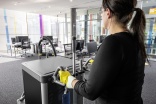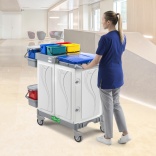Home › magazine › product features › Trolleys too posh to push
Trolleys - too posh to push
30th of January 2025Pushing a trolley laden with buckets, appliances and chemicals can represent a significant physical challenge for a cleaner. Ann Laffeaty looks at some of the ways in which producers are helping to ease the strain.
Trolleys provide an easy method of moving cleaning materials from A to B. But when they are loaded with buckets, mops, vacuums, cloths and water, how easy are they to push? Not very, say manufacturers who are working hard to come up with systems that facilitate the movement of cleaning materials around a building.
Pushing a trolley with an excessively heavy load can result in injuries to the back, shoulders and arms over the long term, says Filmop’s business development manager Paolo Scapinello.
“Designing a trolley without taking ergonomics into account can have a negative effect on the health of operators and increase the possibility of occupational illnesses,” he said. “Similarly, forgetting those factors that are strictly related to operator safety when handling the trolley can add to the risk of accidents at work.
“One should therefore evaluate all those elements likely to minimise stress in the design phase - such as the lightness of the components, usability of the handle and the ability of the wheels to glide freely over surfaces.”
He says it is also important that the cleaner should stand at the correct distance from the trolley to avoid the risk of impact and injury when he or she advances and retracts.
“The position of the handle in relation to the height of the operator is another crucial aspect in terms of usability,” he adds. “However, the fact that operator height can vary significantly makes it difficult to position the handle at a height that suits everyone.”
Adjustable handles are an important factor in any trolley design, according to Scapinello. “This allows the operator to push, pull and manoeuvre the trolley while maintaining a comfortable position,” he said. “In this way, handling-related pains and injuries are effectively prevented.”
Trolley wheels also need to be carefully chosen to ease the pushing process, he adds. “The wheels should allow the trolley to easily glide across indoor and outdoor floors,” said Scapinello. “And reducing its weight will help the operator move it more easily, reducing strain and preventing fatigue.”
Filmop’s Alpha line of trolleys are said to be lightweight and easy to manoeuvre. They can be supplied with an adjustable ergonomic handle and are available with a choice of indoor and outdoor wheels that are designed to cope with any surface, no matter how uneven.
IPC Tools marketing manager Serena Toso agrees pushing a trolley can create physical strain on the part of the operator. “This is particularly the case as far as their back, shoulders, arms and wrists are concerned,” she said. “The prolonged pushing of heavy or poorly designed trolleys can lead to musculoskeletal injuries such as lower back pain, shoulder strain and repetitive strain injuries due to improper posture or handle height.”
Reduce injury risk
Ergonomics are crucial in the design of any trolley system, she says. “They directly affect the user’s comfort and reduce the risk of injury,” said Toso. “Features such as handle height, angle and grip are essential for ensuring a proper posture and minimising the amount of strain during use. In fact, ergonomics are among the most important considerations – particularly for cleaning professionals who push their trolleys for extended periods.”
Systems that ease trolley movement include adjustable and ergonomic handles, a lightweight chassis, manoeuvrable wheels and an overall compact design, she says. “For example, our new Motto trolley features a higher ergonomically-designed handle which helps to prevent incorrect spinal posture and that can accommodate a range of operator heights. And the compact, lightweight design of the trolley enhances manoeuvrability.”
Technological advancements such as electric trolleys, ‘follow me’ technology and robot trolleys are being developed to reduce physical exertion for cleaners, according to Toso. “These technologies help to automate movement or assist cleaners in pushing heavy loads with minimal effort,” she said. “However, electronic trolleys are not the cheapest models so this is very much a ‘plus’ option for customers in the manual cleaning sector.”
Trolleys can be made to be easier to push in a number of ways, she says. “Reducing the amount of equipment on them or using lighter components such as vacuums, buckets and mops can alleviate some of the strain, but this alone may not be sufficient,” she said. “Many trolleys are required to handle heavy tasks and to carry increasing amounts of supplies to cover larger areas.
“A significant weight contributor is often the volume of cleaning water and detergents in the buckets - and this can have a major impact on manoeuvrability. A practical solution is to use a dosing system that allows the operator to carry only the necessary amount of detergent for each task, significantly reducing the load.”
Designing trolleys with detachable or stackable components can further enhance ease of transport and overall usability, said Toso. “This will then make them more efficient for operators when working in different environments,” she said. IPC offers the Ekos dosing system to reduce water weight and the Motto double bucket trolley which has detachable components. Also from IPC is the Kinetic wringer which is said to feature a secure grip, a comfortable working angle and a 360° free rotation system claimed to reduce effort and allow operators to maintain a good posture.
Pushing a heavy trolley can lead to physical strain if the components have not been engineered for ergonomic usage, according to new product development manager at Robert Scott Gavin Holmes. “High-quality wheels will result in a smooth rotation on the floor and this will reduce any strain on the part of the cleaner,” he said. “Adjustable handles set at a comfortable height will further reduce the risk of shoulder and back problems. And a lightweight chassis will reduce the overall effort required to move the trolley.”
Follow-me technology is another good solution, according to Holmes. “This uses hands-free automation which completely removes the need for the operator to manually push the trolley,” he said. “With the aid of sensors and a motor, the trolley will follow the cleaner who will be armed with a remote control. The fact operatives are not required to repeatedly return to their trolley or move it helps to reduce the physical strain and enables more efficient, on-the-go cleaning. And that enhances productivity and improves job satisfaction.”
Follow-me-enabled trolleys are particularly useful in situations where staff are constantly on the move, according to Holmes. “They are ideal when operatives are mopping a floor or putting in place ‘wet floor’ signs, for example, because the trolley is able to safely navigate around obstacles behind them,” he said.
New from Robert Scott is the Exel Follow-Me Smart Trolley which features hands-free technology and an innovative accessory rail that allows for numerous configurations, according to Holmes. It comes equipped with a 45-litre waste bag and a built-in checklist holder, while two of the wheels feature a brake.
Competitive advantage
Ergonomics are an important factor in the manufacture of any trolley, says senior sales director of Kärcher’s manual tools department Michele Redi. “Trolleys need to offer an intelligent combination of characteristics such as ease of use, efficiency, ergonomics, sustainability and an attractive design,” he said. “But in view of the growing shortage of personnel and increasing cost pressures we feel ergonomics may become a competitive advantage for building service providers in future.”
A trolley needs to be a helpful aid – and not a transport tool that becomes a burden for the cleaner, he said. “When developing our Flexomate janitorial trolleys we surveyed service operators internationally on their challenges and on-the-job-related physical issues they faced,” said Redi. “These valuable feedbacks were then taken into consideration by our engineers when designing key components such as the handle, drawers and the tilted tray.”
All handles should be ergonomic and height-adjustable at the touch of a button, he said. Tilted boxes and trays where mops are stored are said to prevent the operator from having to bend their back to access them and help them to keep a straight posture while picking up a clean mop.
Kärcher’s Lampo system is fixed on the base of its Flexomate trolleys and allows the operator to switch between dusting and washing operations by clicking in the desired plug while standing. This avoids the need for them to bend their back or touch the frame or the mop, says Redi.
There are many other ways in which the cleaner’s load may be lightened, he says. “Operators need to be able to transport various items and appliances such as vacuum cleaners, and the manufacturing technology of trolleys is very much oriented towards plastic rather than metal,“ he said. “Polypropylene is one of the most widely used materials and is lightweight, shock-resistant, chemical-resistant and can be used as part of a colour coding system. And we use aluminium lateral profiles which are rust-free and very light.”
The transportation of water to and from the cleaning area needs to be reduced as far as possible, he says. “There are still a lot of heavy buckets of water being carried around and cloths that have to be immersed and then wrung out,” said Redi. “The use of pre-impregnated mops is preferable since this will lower the weight of the buckets.”
Kärcher machines can be integrated into the company’s janitorial trolleys to increase productivity and save time, says Redi. The modular system of its Flexomate trolleys is designed to allow cleaners to move around a building with a large trolley and use the smaller element in narrow, restricted spaces.
Trolleys should be designed to be as easy as possible to push – but manual tools also need to be relatively simple, says Redi. “When people choose a cleaning tool it is mainly a question of habit, user-friendliness and budget, and they don’t expect to have to deal with electricity or electronics,” he said. “This is why sophisticated trolleys such as motorised ones or those that use ‘follow me’ technology are still thin on the ground.”
However, he adds Kärcher is constantly working on new solutions for its customers. “We will be using our expertise in the field of robotics for future innovations in the trolleys sector,” he said.









